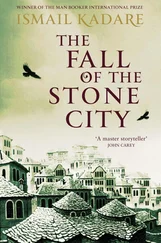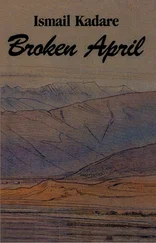Hemiunu went on talking to him. He explained why he had chosen a slope of fifty-two degrees rather than one of forty-five. He invoked the legendary name of Imhotep, the first pyramid builder, provided information about the new pyramid’s orientation, which had been fixed by the position of the stars, but Cheops’s mind was elsewhere. He got a better grip on himself when the High Priest used a piece of a plank to show on the model how the stones would be raised. “That’s just what I wanted to ask,” said Cheops. “At such heights…” “No problem, Majesty,” the architect replied. “You see this wooden scaffolding? We shall build four like that, one for each slope. The stones and the granite blocks that serve to obstruct the entrances will all be hauled up the ramp by means of ropes.”
He propped the piece of wood against the model It would lean on the pyramid, like that, there you are. On the lower steps the gradient of the ramp would be very gentle. Then as the height increased the slope would get steeper, which would make it harder to raise the stones. To keep it manageable, in other words to keep the angle of slope at less than twelve degrees, the ramp would be progressively extended in length. That’s how, like this…
The architect removed the first ramp and put a second, longer one in place. “You see. Majesty, this one reaches the pyramid at mid-height, but the gradient is just about the same.” Cheops nodded his head to indicate that he had understood, “And so we shall go on, to the summit,” the architect continued, moving into place a third and much longer piece of wood. “Now the pyramid looks like a comet,” Cheops said, and for the first time he smiled.
Hemiunu sighed with relief. “And what’s that arrow, there?” the Pharaoh asked, pointing the rod he held in his hand toward a sign.
For a short interval the architect held his tongue.
“That is the gallery that leads to the funeral chamber, Majesty,” he replied without looking at Cheops.
The Pharaoh touched the sign with the tip of his rod.
“And where is the chamber itself?”
“It has not been included in the model, Majesty. It has no place in it, because it is situated outside of the pyramid. It is buried underground. One hundred feet deep, maybe more… At a point where the weight of the pyramid is no longer felt…”
Cheops’s eyes wandered for a moment to the abyss where they planned to place his coffin. He recalled a dream he had had a few days before. He had seen his own mummy floating in the void like the body of a drowned man.
“That is how the great Zoser and the unforgettable Seneferu, your father, were placed,” said Hemiunu, lowering his voice.
Cheops did not reply. He hardly felt at his ease, but made an effort not to let it show. Only the rod in his hand trembled.
“Such matters are your business,” he blurted out in the end, and then turned on his heels. His last words: “Start your work,” which he uttered once he had crossed the threshold and without turning his head, reached the architects as if enveloped in an echo: Sta-start you-your wo-work!
Those left behind kept quiet for a moment, like the followers of a sect who had seen some miracle. Approval had finally been granted. The model, the seed of the future pyramid, which only yesterday they had handled and treated without ceremony, now seemed untouchable. Its cold chalky lightness seemed to needle them, and not just them, but the whole world.
The access roads were built according to the rules, that is to say simultaneously from different points in the kingdom. All trace of the old routes leading to the previous pyramids had disappeared a long time ago. Here and there, you could make out barely a few remnants, the scars of wounds healed years before. But even if they had survived they would not have been easy to use for the new pyramid. Each one had its own routes, which depended in some cases on the state of the old quarries and on the new quarries that had to be opened, on the kind of granite used (whether it was Aswan or Harnoub stone), on the choice of alabaster or basalt for interior decoration or for the summit, called the pyramidion, as well as on the material from which the sarcophagus would be carved — hard rock, red granite, or basalt The other materials that would be brought to the site ready-made — the granite buffers for blocking the entrances, the pedestals and plaques that would bear the inscriptions — could of course be conveyed along the old roads, but sometimes also needed new ones. Everything depended on the place where they were manufactured.
All that no doubt made up the most precious and elaborate part of the project, but the main thing was’the stones. Dozens of high officials in charge of works lost sleep over their extraction and haulage. As if it was not enough to have to devote most of their energies to these myriad nameless lumps, they were obliged in addition to spend days and nights on drafts and endless calculations of all kinds.
It was not just a matter of determining the exact number of stones needed, nor the average number of man-hours required for the extraction and loading of each block. After loading came haulage, and that was where everything went awry. Since it was indispensable to use the Nile for moving masonry and other materials, all their plans had to take account of the water level and of the possibility of spates. In earlier times, for reasons of security, people had tried to do without the Nile, but calculations had shown that recourse to other means of movement would have doubled, not to say tripled, the length of the journeys, so that (keep your voice down!) the Pharaoh risked dying before his pyramid was finished.
In this as in all else, the Nile turned out to be irreplaceable, However, it was not at all easy to predict exactly how far rafts laden with stone or granite could travel in this or that season. You had to consider all the possibilities, especially when planning long journeys beginning as far away as Elephantine, or even further from Dogola or Gebel Barkal.
Deep in their calculations, the high officials and the shippers entrusted with the transportation of building materials considered justifiably that the main responsibility for the pyramid lay with them; and if someone had pointed out to them that at the same time other guilds were also losing sleep over the plans for the pyramid — for example, the architects, who had not yet solved some of the problems, such as the pyramid’s gradient and its orientation with respect to the stars, or the team in charge of interior arrangements, or the team of sculptors — they would certainly have retorted sourly, but those are just girlish tasks, hair-splitting fancy-work! The pyramid is where dust gets under your skin, where heat and death bear down on you at every step. But the architects themselves would have snarled at the shippers in the same way, especially those who pored over their drawings of the galleries, doors, and secret passages, or busied themselves with the mysterious inner chambers, forgetting entirely that at the same time the haulers were covering half of Egypt with dust: a common porter’s job!
Perhaps the very nature of each guild’s task led it to think that it was the main one. That was the case for the architects, for instance, who strove to fix the right orientation for the pyramid, and for whom the local expression “to make night into a new day” had much more than a symbolic meaning. In practice, they did a good part of their work at nighty when they would go to the plateau on which the pyramid was to be built, not without casting rather disdainful glances on the trench-digging team. Although it had been decided irrevocably that in order to avoid all possibility of error the monument would be oriented in relation to a fixed star, a star from the Great Bear (but absolutely not the polestar), they continued to go almost every evening to the site at the hour when the workmen were laying down their tools, Ah, the workers thought, to have business with the stars, that’s what you call keeping your hands clean! Those chaps don’t know what calumny and betrayal are! But just try getting this right (and they stamped the ground with their heels) at the final inspection. You can be just a couple of fingers higher or lower than the level prescribed, and your head’s on the block!
Читать дальше












